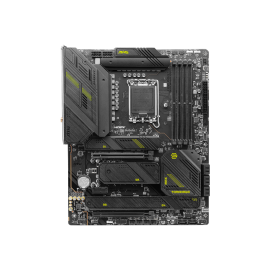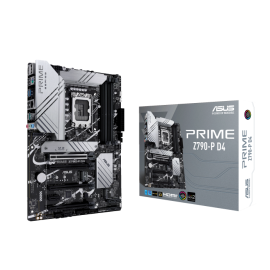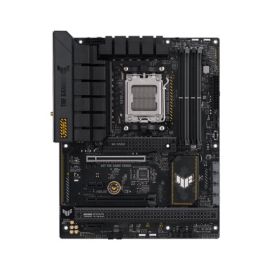-
MSI PRO B760M-E DDR4 Motherboard, Support Intel Core 14th/ 13th/ 12th Gen Processors, Micro-ATX, LGA 1700
Special Price BHD 55.10 was BHD 70.98 -
ASRock Motherboard Intel Z790 PG Lightning/D4,Supports 14th, 13th & 12th Gen Intel Core Processors,4 x DDR4 DIMMs,7.1 CH HD Audio,Realtek 2.5G LAN
Special Price BHD 134.14 was BHD 189.48 -
MSI PRO Z890-S WIFI Intel Z890 LGA 1851 ATX Motherboard 256GB DDR5, M.2 Gen5, Wi-Fi 7, Thunderbolt 4, White
Special Price BHD 118.38 was BHD 153.93 -
MSI PRO Z890-A WIFI Intel Z890 LGA 1851 ATX Motherboard 256GB DDR5, M.2 Gen5, Wi-Fi 7, Bluetooth 5.4, 2.5G LAN, Silver
Special Price BHD 162.23 was BHD 169.34
Intel Motherboards
The most performance-oriented PCs in the world use the Intel motherboards as a base. They interlink Intel Core processors, memory, graphics, storage and peripherals, and offer consistent power delivery, optimized chipset communication, and the features that gamers, creators, professionals, and enthusiasts of different regions desire. Intel motherboards support Intel Core i3, i5, i7, i9 12 th, 13 th, and 14 th of generation CPUs and even workstation-level Xeon processors to serve systems as small as mini-ITX PCs to full-tower gaming computers and even content creation workstations.
These new Intel motherboards have dual-channel DDR4 or DDR5 support, PCIe 5.0 x16 and x4 slots, several M.2 NVMe SSD ports, USB-C and USB 3.2 Gen 2x2 ports, Thunderbolt 4, on-board Wi-Fi 6E or 7 and fast multi-gig Ethernet. Premium, well-designed and engineered power delivery and VRM architecture guarantees system stability with high-end workloads, robust PCIe slots, M.2 heatsinks, chipset filters, and cooling features support overclocking, huge core, and future-proof workloads. Global uniformity means that Intel motherboards are best suited, compatible and have localized ecosystem compatibility across all markets of the world.
CPU compatibility and Chipset compatibility
Intel motherboards will support multiple interchangeable socket platforms with chipsets. LGA 1700 supports both 12 th and 13 th generation Intel Core processors, with dual compatibility of DDR4 and DDR5 memory support, whereas the next generation, LGA 1851 used with 14 th generation Intel Core processors, brings some upgrades, including the fact that it will run at lower voltages and have better PCIe lane capacity. The chipsets are H610, B760, Z690, Z790 and W-series that can be used in a workstation. All chipsets levels are distanced by PCIe, storage expansion, memory profiling as well as I/O options.
Entry-level H and B chipset provide simple functions such as single M.2, moderate front-panel USB lanes and basic overclocking capabilities where allowed. Z690 and Z790 supports full CPU and memory overclocking, many lanes of PCIe 5.0, two or three M.2 connectors, higher VRM arrays and fan or passive chipset cooling. Platforms W680 and W790 are workstation-oriented and feature ECC memory, number of PCIe expansion slats and networking features supported by Intel and ISVs. Selecting the right chipset makes sure that you will have a system that is right in terms of performance, cost, and applications anywhere in the world.
Build flexibility and Form Factors
Intel Motherboards are in formats such as, ATX, Micro- ATX, Mini-ITX and Extended ATX. Full-size ATX boards have maximum expansion capability (many PCIe x16 slots, large RAM), and are used on compact systems, as well as desktop systems where the entire dimensions of the system are not critical, and where full-size expansion capabilities are required. Micro-ATX are the middle ground in terms of both size and expansions, mini-ITX are aimed at the small form factor with some of the most essential specifications such as single-x16 GPU compatibility, integrated Wi-Fi, and dual memory channels. Extended-ATX boards are used to support high-performance workstation systems that incorporate multiple graphics cards/accelerators. Users in various regions will use form factors according to the case availability, air flow, port density, and aesthetics.
Memory: DDR4 vs DDR5 Sets
Intel motherboards support DDR4 as well as DDR5 memory. DDR4 boards are relatively affordable and allow building a high-performance system with popular memory kits to DDR4-3600/DDR4-4000. Next-generation memory sources DDR5-5200 to DDR5-7200, increased power efficiency, built in power regulators and XMP 3.0 memory profiles. DDR5 technologies are forward-looking, and DDR4 is good enough concerning mainstream systems.
Storage and Enlargements
The modern Intel motherboards have several options with regard to storage. PCIe 4.0 x4 M.2 NVMe SSDs are supported in dual or triple M.2 PCIe, whereas some models support PCIe 5.0 M.2. SATA III port is where SATA SSD and regular hard drive are supported. Graphics cards, NVMe adapters, RAID controller cards, capture devices and AI accelerators can use PCIe x16 and x4 slots. USB-C and thunderbolt 4 possess the capability to support high data speed on those systems that are compatible workstations or creative systems.
Networking and Audio qualities
Motherboards produced by Intel have much wired and wireless sensation. Their common characteristic is the 2.5 gigabit Ethernet, the multi-gig 10GbE modules with the Wi-Fi 6E and the Wi-Fi 7 (that is on the horizon) that supports low latency online gaming, live online streaming and downloaded files. There is in-built Bluetooth support that enables wireless accessories and music.
Sound offerings include basic Realtek sound (codecs), high-quality ALC4080 or DTS-capable chips (isolated audio PCB traces, amplified headphone jacks and nichicon capacitors). These sound systems respond more aptly to immersive games and creation audio use as well as multimedia consumption.
Thermal design and Power Delivery
In fact, good support needs excellent VRM set ups and Intel motherboards have anything between a simple 6+1, to the top-quality 20+1 or 24+1. High end boards offer heatsink, heatpipes and active cooling chipset fans, whereas the mainstream boards are dependant on subtle yet sturdy passive cooling. Specialized fan connectors permit control over airflow of a chassis, and diagnostic LEDs and Q-LEDs enable troubleshooting of boot or hardware problems.
Such thermal options provide the opportunity to be stable under long-time work, games, renders, streaming, or overclocking, and minimize the chances of throttling.
BIOS software and tuning tools
Intel motherboards are designed and constructed in a manner that supports an intuitive UEFI BIOS interface having features such as EZ-Mode together with fan control, secure boot and overclocking presets. Z-series boards have a simplified overclocking feature of CPU and memory, memory calibration, and personalized voltage curves. BIOS flashback buttons and dual BIOS chips, and flashable firmware to rescue after failed updates, are commonly added to many boards as well.
Motherboard manufacturers have developed software suites that allow control of RGB lighting, LAN traffic prioritization, system monitoring and tuning of performance. There is also an idea to use mobile app to monitor and control in real time through a smartphone.
Applications Applications Usage Cases
Motherboards made by Intel are perfect in different application situations:
• Gaming: Low-latency networking, support of high-refresh-rate monitors, dual GPUs, fast storage loading make them ideal not only in competitive gaming, but also in casual gaming all around the world.
• Content Creation: Multiple M.2, USB-C front panel, Thunderbolt 4, high-quality audio, ECC/large memory, stable and reliable power delivery, provides a smoother editing process, rendering performance and streaming.
• Mini-ITX Systems: Smaller constructions attain all main functions Down low with Wi-Fi and in-built audio.
• Workstations: ECC capable W-series boards provide many PCIe lanes to satisfy video and compute cards, and support professional usage, as well as server-level mounting.
The selection of a board relies on the purposes, upgradeability, affordability, and compatibility in a region.
Reliability and Performance Feedback
The quality of Intel motherboards is commonly celebrated, as well as VRM and stable builds, consistent BIOS updates, and easy access to diagnostics. Gaming boards gain positive reviews in terms of flexibility of performance tuning, memory support, reliable networking and RGB customization. Early versions of some entry-level models suffered very early BIOS bugs (which were normally fixed by subsequent firmware upgrades), although they were largely eliminated by manufacturer firmware tools. ECC retention, thermal durability and board life are attributes that workstation boards are lauded over. Intel motherboards on the whole are reliable to use and last years so long as they are properly maintained and got firmware updated occasionally.
Current trends and New Features
Other trends in Intel motherboard are the more widespread use of DDR5 memory, PCIe 5.0 support on GPUs and storage, wireless networking with Wi-Fi 7 on households and offices, Thunderbolt 4 on creative workflows, and ground-up mini-ITX form factor motherboards with full-power VRMs. The other users who also enjoy AI supported tuning include auto overclocking and real time temperature control.
Higher-end PCBs now enable DDR5 speeds up to and above 7200MT/s and support new PCIe 5.0 M.2 ports in next-gen SSD speeds. The ecosystem of RGB is being enhanced to provide immersive lighting which can synchronize within hardware. The fact that firmware needs to be maintained guarantees that new CPUs and security-related updates can be used.
Final Summary
The motherboards made by Intel integrate connectivity, power, and tuning, reliability, allowing designers in every corner of the planet to build a gamer machine, a creator base, a compact PC, or a workstation. These boards have the flexibility of the future with support of DDR4 and DDR5, PCIe 5.0, Wi-Fi 7, Thunderbolt 4, and effective VRM cooling. When a global user is in need of performance, durability, and future capabilities, in selecting the right Intel motherboard, a stable platform of the present computing and future upgrades is provided.






















